TR’s 10 Best Comics Read in 2013
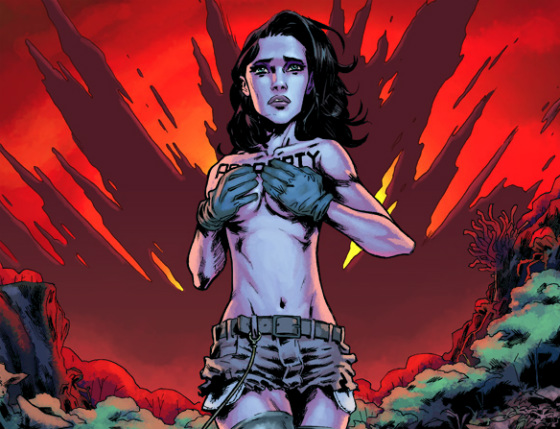 |
Reading comics can bring many great joys into a nerd’s life. Despite the many things it can give, however, there’s one thing that comics can take a lot of… money. Comics can easily go from being a cheap hobby to an expensive habit; there was a time in my life when I would spent over $100.00 a month at my local comic shop. My last few years of being a broke college student have removed that from being a viable option in my life, but it hasn’t removed the desire to read a lot of stuff. Fortunately the city of Eugene Oregon gives broke blokes like me a more frugal option to indulge in the nerdly delights of sequential art. Like many cities in the US, Eugene’s Public Library has a robust and growing selection of graphic novels for patrons to check out.
While my local library affords me the opportunity to keep up on my favorite stuff and find loads of new favorites there can be some drawbacks. Most notable are the need to wait for the library to order in new volumes of whatever’s come up the pike and then having to wait on a hold list with a dozen other people dying to read the same thing. As a result I’m often behind the curve of what’s going on. Accordingly, some of the volumes appearing on this list might not have actually been published in 2013, but I assure you they were all read this year. So now it’s time to see which of this year’s massive reading stack made the grade for creme of the crop.
#10. Orchid
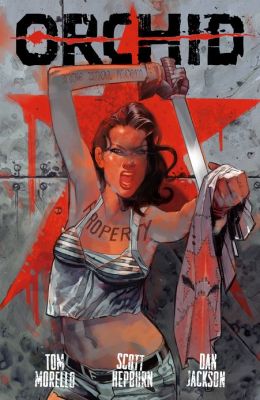 |
A post-apocalyptic series by former Rage Against the Machine guitarist Tom Morello, Orchid takes place centuries after global warming has transformed the earth into a wasteland. In addition to heavy flooding, animals have evolved into deadlier predators leaving humanity in very bad shape.
The story starts out years after a failed revolt against a tyrant with a new revolution trying to get off the ground. The lone escaping member of a band of freedom fighters makes his way to a ghetto community and gets thrown into an uneasy alliance with a young sex slave named Orchid. The two of them eventually meet up with a woman named Opal who was part of the last revolution and may know some secrets about an allegedly magical mask used by legendary leader General China.
One of the most refreshing things about Orchid is that even though it’s created by a celebrity, it’s not a vanity comic. Far too often, celebrities entering the medium of comics create a story centered around a character that is a very obvious stand-in for themselves but a more badass version thereof. Morello foregoes that route and instead delivers a fully fleshed out world full of fascinating history and background with characters that feel created from whole cloth. In Scott Hepburn, he’s found the right artist to give his world the dingy, grimy, lived-in look and feel that a post apocalyptic jungle should have.
#9. Think Tank
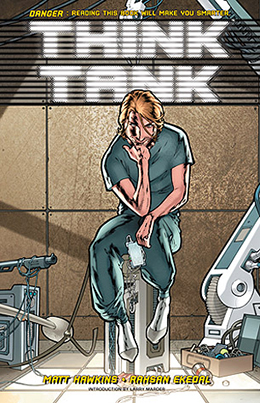 |
A refreshingly realistic sci-fi series, Think Tank follows the plight of David Loren, a gifted genius who was recruited by DARPA at the tender age of 14 to create hi-tech wonders for the military industrial complex. In recent years, David’s developed a conscience, as he’s realized the horrible uses being applied to his inventions. Unfortunately he’s also realized that he’s too valuable an asset to the US government to ever be allowed to walk away from his job.
The first volume features David’s attempt to escape from the top-secret facility where he’s lived and worked for most of his life, and the escalating problems he creates for other people in his attempts to break free. The most fascinating part of the story is that all of the gear David uses is based on real world tech, or something being developed or sought by RD firms working for the government. Author Matt Hawkins blends science and politics into a gripping tale of adolescent naivete running into the cold hard truths of adulthood, and artist Rahsan Ekedal brings a fluid cartoonishness that complements the protagonist’s irreverent humor without compromising the series bleak tone.
#8. Nemo: Heart of Ice
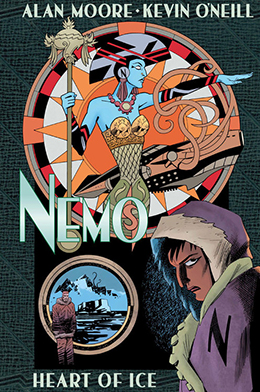 |
A spin off from Alan Moore and Kevin O’Neill’s League of Extraordinary Gentlemen this story focuses not on the original Captain Nemo of previous installments, but instead on his daughter Janni who is struggling with living under the shadow of her adventurous father.
Continuing to borrow from other fictional universes, Moore incorporates elements of Lovecraft into this tale. When Janni decides to prove herself every bit the adventurer her father was, she takes the crew of the Nautilus to Antarctica hoping to finish an expedition that he abandoned – which unsurprisingly turns out to have been abandoned for a very good reason.
Heart of Ice takes a familiar story trope of a woman trying to prove herself and offers the fresh angle of that woman starting to wonder if maybe the life of action and adventure isn’t for her after all. When the Lovecraftian stuff kicks into higher gear and Janni’s group arrives at the Mountains of Madness, Janni realizes a bit too late that she’s in over her head.
#7. Crossed: Volume 4 – Badlands
 |
Survival horror stories can often feel very “dime a dozen” in our current pop cultural landscape which is currently overrun with zombies (pun intended). One of the few refreshing takes to be found is Crossed, which started off as a mini-series by Garth Ennis that wasn’t originally intended to continue beyond its initial 9 issue run. While most zombie or zombie-like stories focus on George Romero-style shambling corpses, Crossed borrows more from modern offering such as 28 Days Later. Characters lives are upended when a mysterious virus suddenly hits all across the world, turning people into psychotic maniacs with cross-shaped scabs on their faces and a driving need to rape, kill and eat their fellow humans (though not always in the same order).
When Avatar Press convinced Ennis to let other creators run with the idea it resulted in some great mini-series from creators like David Lapham before rolling over into an ongoing series titled Badlands. The first volume of Badlands (which is the fourth volume to be collected overall) starts off with a 3 part tale by original creators Ennis and artist Jacen Burrows that takes place northern Europe, where a group of survivors are hoping to avoid the crossed by going out into the coldest terrain they can find. The volume is rounded out by a 5-part tale from Jamie Delano and Leandro Rizzo set in the Florida Everglades, where a small group comes together only to fall apart because of their own internal flaw.
The thing that sets Crossed apart from a lot of its kindred stories of survival is that it presents the survival itself not as some noble all important goal, but rather as a futile attempt to avoid the inevitable. While other stories have characters reminding each other of the importance of retaining their humanity in the face of brutality, Badlands poses the question of whether it might be better to simply give up and accept the brutal truth of the world as it now is. The final moment with one character considering whether or not to willingly be infected rather than struggling against the odds makes for some of the most gripping horror to come along in years.
#6. The Walking Dead Volume 17: Something to Fear
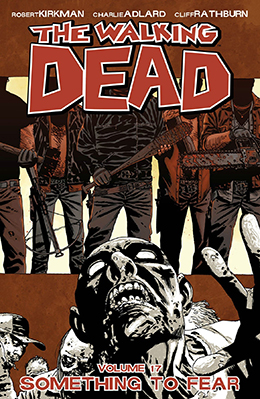 |
Speaking of stories that champion the drive for survival and maintaining human dignity, The Walking Dead continues to be a thrilling read. Last year’s volume 16 laid the foreshadowing for a bigger threat than Rick Grimes and his group of weary survivors had ever faced before, and the follow-up delivered in spades. A warlord by the name of Negan is introduced, along with his army of “Saviors” who extort food and supplies from communities like the one that Rick’s group has joined.
When Negan’s troops attempt to shake down Rick and his community, the initial response is a resounding “no,” backed up with force when they’re attacked. The small victory soon turns sour when Rick’s group are ambushed along the road to Hilltop. Negan himself arrives to lay down a new law and demonstrates that he’s not fucking around by taking out one of the group in a brutal and merciless fashion, brought to ugly life by the expert hands of artist Charles Adlard. With the stakes raised much higher than ever before, Kirkman leaves off with some final pages that make the following volume 18 an absolute must read.
#5. B.P.R.D. Hell on Earth Volume 6: Return of the Master
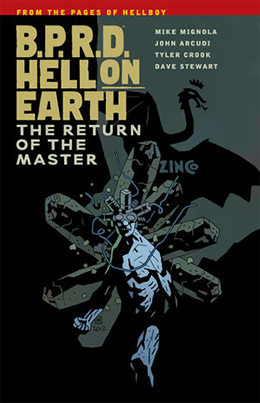 |
One of the most enjoyable elements of Hellboy and its spin off B.P.R.D. (short for Bureau for Paranormal Research and Defense) is the lack of a status quo. When characters die they tend to say dead (or at the very least take a really long time to come back to life) and when things go wrong they tend to stay wrong or get worse. For example when Hellboy got pissed with the Bureau about planting a bomb inside his homunculus buddy Roger and quit, there was no subsequent reconciliation or even any communication with his former team mates. Hellboy made a clean break and went off on solo adventures, while the Bureau got their own series and characters like Liz Sherman and Abe Sapien moved on with their lives.
This fine tradition of moving forward was carried on when B.P.R.D. climaxed with a series of catastrophic events that left the world forever and irreversibly scarred. The following Hell On Earth series has had a bleak tone of futility and despair as the world continues to get worse while the good guys provide little more than damage control of diminishing effectiveness.
The latest volume involves the culmination of a long in the works plan to resurrect the infamous Grigory Rasputin who has been instrumental in the efforts to bring the Lovecraftian Ogdru Hem creatures to Earth to usher in an apocalyptic rebirth of a new world. As his followers scheme, the Bureau is still reeling from recent calamities and losses while trying to follow some leads and figure out where the next big threat is coming from. Writers Mike Mignola and John Arcudi continue to deliver a gripping tale while Tyler Crook brings a curvier, slightly more cartoony flavor of art that still captures the grisly and brutal viciousness of the various monsters plaguing the world.
#4. Chew Volume 7: Bad Apples
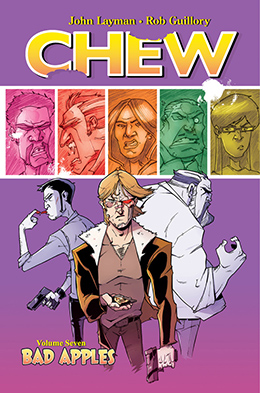 |
One of the best crime noir/comedy stories to ever come along, Chew follows the adventures of Tony Chu, a federal agent who is also a cibopath, which means that he can feel the life experiences of whatever he eats. The series takes kooky ideas like this or cyborg-fighter chickens and treats them with a deadly sincerity that makes the absurd seem intensely serious in addition to freaking hilarious.
In this volume, Tony is reeling from a death in his family and reacts by burying himself in his work in order to find the ones responsible for his loss and make them pay. Seeing the character go all bad ass and intense after so long as a milquetoast sad sack is something rather cliche, but in the hands of writer John Layman (who’s spent multiple volumes planting the seeds for this evolution of character) it’s executed brilliantly. Artist Rob Guillory delivers a vibrant manic vibe that melds well with the odd ideas abounding throughout the story. The stage continues to be set for an epic showdown that will no doubt have another volume of this series end up on a future years best list.
#3. Hellblazer: Death and Cigarettes
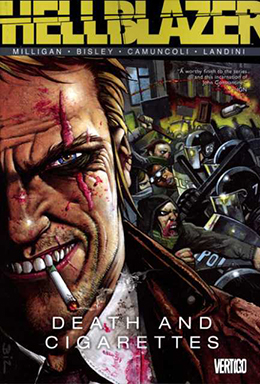 |
One of the most heartbreaking bits of comics related news in 2012 was the announcement by DC Vertigo that the long running series Hellblazer would be coming to an end with issue #300. While it’s sad to see the original John Constantine put out to pasture so more focus can be placed on his younger New 52 counterpart, writer Peter Milligan delivered a fitting send off for the cheeky old bastard.
After a pair of fun one off stories illustrated by cover artist Simon Bisley (including a great werewolf story), Milligan picks up on the previously introduced thread of John’s sister Cheryl having been revealed to have had an illegitimate son in her teens. Having promised the ghost of his sister that he’d find his nephew and make sure he was okay then immediately backing out of it, circumstances force John to investigate the matter anyway when dead bodies start turning up. Fearing that his missing nephew is another victim of the ‘family curse’ of madness and magic that has plagued his kin over the generations, Constantine finds that things are even worse than he’d guessed…but for much different reasons. Giuseppe Camuncoli gives this tale of the latest addition to John’s twisted family tree the proper jagged brittle edge it deserves and does the same for the series finale as well.
The collection is closed out by the titular 3-part story arc where Constantine sees signs and portents that he’s going to die in a few days, and then makes the unexpected move of accepting his fate and saying his goodbyes. Naturally some twists and turns pop up along the way and Milligan leaves the door open to bring John back to readers if DC ever changes their mind, but if this ends up being the final hurrah for the longest running series Vertigo ever printed, it’s a hell of a way for the character to exit the stage.
#2. A God Somewhere
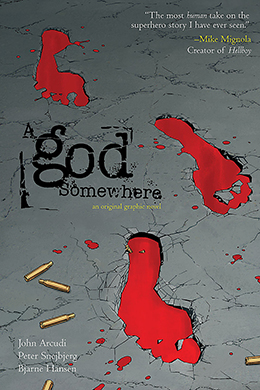 |
This is a hard entry to write about without feeling like it’ll ruin the experience of reading it. The evocative title and eye catching cover are enough to get one to pull the book off a shelf and take a glance. With that in mind it’s strongly suggested that you skip the rest of this entry and go read the graphic novel instead of the following plot synopsis.
What starts out as an quiet suburban tale of two brothers and their best friend acclimating to the changes brought on by adulthood takes a loud shift in direction when a mysterious explosion at the apartment of younger brother Eric ends with him not only being alive, but also having super powers. After going a few miles down the standard road of newfound fame and admiration for his heroics, the story turns an interesting corner when all that fame goes to Eric’s head and he develops a God complex, then goes on a rampage. By showing what a lot of people might actually do with superpowers, author John Arcudi (who did similar deconstructions with The Mask and Major Bummer) takes one of the favorite fantasies of nerds everywhere and sours it with a harsh dose of reality. Artist Peter Snejbjerg gives the visuals an appropriately smudged and dirty feel that lends the eventual swath of destruction and turmoil a visceral intensity that works brilliantly.
#1. (Tie)
Saga by Brian K. Vaughan and Fiona Staples
and
Manhattan Projects by Jonathan Hickman and Nick Pitarra
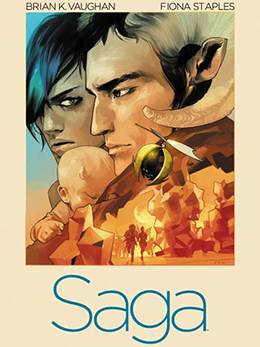 |
 |
When I did this list last year the two biggest complaints were “How could you leave out Saga!?” and “How could you not include Manhattan Projects!?” Enough people chewed me out for leaving these titles off the list that they were immediately added to my hold list at the library to see what I was missing. The answer was, “a helluva lot.”
Saga is a grand space opera/fantasy in the tradition of Star Wars and Lord of the Rings with a healthy dose of Romeo and Juliet. It follows the adventures of star crossed lovers Alanna and Marko, who come from warring alien races, and their newborn daughter. As the new family flees assassins from both sides, they end up stumbling into one problem after another. Vaughan continues to be one of the best storytellers in the field and Staples’ art has the feel of a gritty cartoon series that would have fit in on MTV’s Liquid Television.
Manhattan Projects is set in an alternate universe where the project to build the atomic bomb was a cover for even more amazing scientific endeavors such as A.I. and travel to parallel universes. The series cast is comprised of reimagined versions of famous scientists like Albert Einstein, Richard Feynman, Wernher Von Braun and the devious Joseph Oppenheimer (who in this reality had a twin named Robert that he killed and ate). Hickman taps into the pulpy feel of classic sci-fi tropes from the ’50s and infuses them with a modern taste of bleak bitterness. It feels like the kind of bold concepts that made up classic matinee movies, balanced with the previously suppressed knowledge of the kind of dirty things the military industrial complex would actually do in the pursuit of dominance. Meanwhile Pitarra gives the setting a zany cartoony feel with his curvy style that’s reminiscent of Frank Quitely without feeling like an imitation.
These two series represent one of the best feelings that can come from nerdy media; a story so cool and unique that people feel a driving need to passionately insist that others read it. So by all means, please use the comment section below to chew me out for anything I left off this years list – so I have more stuff to enjoy in 2014.
Previously by Greggory Basore:
The 30 Best Origins of Superman
16 Heartbreakingly Awesome bits of production art that never made it to the screen.
